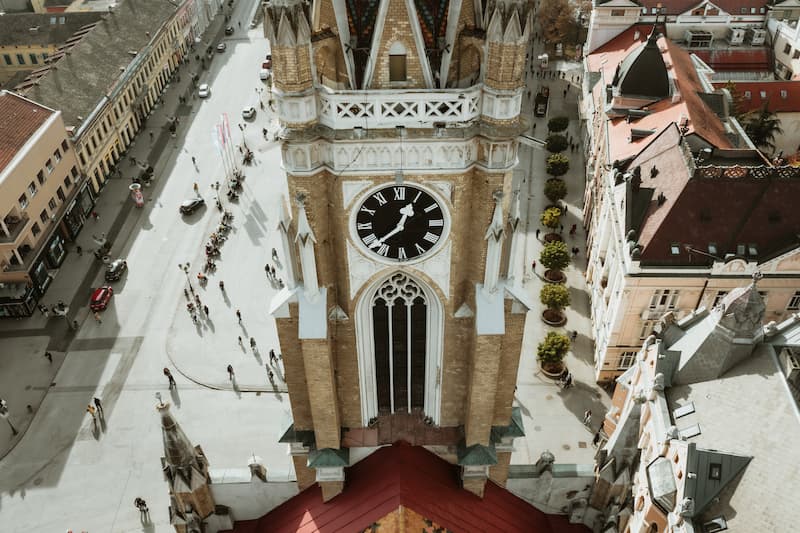‘Let’s meet near the clock?’ The mentioned clock in Novi Sad could be on the Cathedral, Train station, or Petrovaradin Fortress. They are the recognisable symbols of the city, although you can see clocks in some other places as well. People have always given importance to clocks and the time they measured. An artist who lived in our city said in one of his songs: ‘Clocks on all my churches stopped. Clock hands, fortunately, at that moment overlapped. I know hundred thousand words, but I am missing one…’ Of course, it’s the ‘Newcomer’ (sr. Dođoška) song and Đorđe Balašević.
We will tell you more about the famous Novi Sad clocks…
The Clock Tower at the Petrovaradin Fortress
The first of these clocks is not on the Novi Sad but on the Petrovaradin side, and it has always been significant for the citizens on this side of the Danube. The tower with a large clock is situated at the St. Louis’ bastion at the Petrovaradin Fortress. The clock originated in Alsace, France, while Maria Theresa gave it to the citizens of Novi Sad as a present at the beginning of the 18th century. The dials are located on all four sides of the tower. The diameter of the clock circles is about 2.5 m, and there are three balls (76 kg) in the clock itself and a walker, which drive the clock mechanism. Today, the clock still works, and it functions the same way it did in the past. It is being wounded manually every day. An old citizen of Novi Sad, Lajoš Lukači, has been winding the clock for years. He got the February Award of Novi Sad for his voluntary work.
There’s an interesting fact about this clock. Namely, the big hand on the clock shows hours, while the small hand shows minutes so that time could be easily seen from a distance. This was done purposefully so that the boatmen on their vessels, as well as the citizens, could see the time from a great distance. During that time, you had to pay in order to use the clock. Except for showing the time, the clock had other purposes as well. Namely, in addition to the clock, there was a mechanism that was used for navigation, but it no longer exists. The boatmen could see whether the river was passable by following the signalling. Thus, the fortress itself played an important role in controlling the Danube navigation. At the very top of the tower are a pointer showing the sides of the world and a weathervane above which is a symbol of a heart, instead of a spear, which is often situated on fortifications similar to this one. Another interesting fact that has to do with this clock lies in its punctuality. When it’s cold, the clock is a few minutes late, while when it’s warm, the clock is a few minutes ahead. This probably has something to do with its mechanism. Due to this, the clock was named ‘The drunk clock’.
The Train Station Clock
The clock always catches the eye of those who would come to or go from Novi Sad, either by train or bus. By the book, there are large wall clocks in every railway station. Thus, a unique wall clock is located at the entrance to the Novi Sad train station. The unique construction of the clock was made in the Insa watch industry in Zemun. Namely, Insa is the last European factory of mechanical alarm clocks. The clock was placed on the building of the railway station in the late seventies of the last century, as a gift from the company Novkabel company to the city of Novi Sad. The clock has not worked for the last ten years. To the great joy of the citizens of Novi Sad and all passengers, the clock was renewed as part of the renovation of the entire railway station, and today, it is working again, thus informing passengers about the exact time.
The Clock Tower of the Name of Mary Church
For a long time, the cathedral was the tallest building in Novi Sad, and there was a clock on its high tower on all four sides. Regardless of the fact that its fellow citizens called it a cathedral, this building is not a cathedral, but the Parish Church of the Holy Name of Mary. The clock was set in the first half of 1895, along with the bells. The construction of this church lasted between 1893 and 1896, according to the project of György Molnár. The church is 52 metres long and 25 metres wide, the roof is 22 metres high and the tower is 72 metres, which makes it the tallest church in Novi Sad. The façade is made of yellow clinker brick, and the bell tower cap and roof are covered with the famous Zsolnay ceramics. Inside the cathedral, below the choir, there is a bust of the architect Molnar, who does not ask for any compensation for this work.

There is a saying that time is more expensive than gold and sharper than sabre, but, certainly, time is not waiting for anyone. Despite that, the citizens of Novi Sad always take their tame, but they always arrive on time!
Author: Historian Ljiljana Dragosavljević Savin, MSc.
Photo: Jelena Ivanović, Vladimir Veličković







